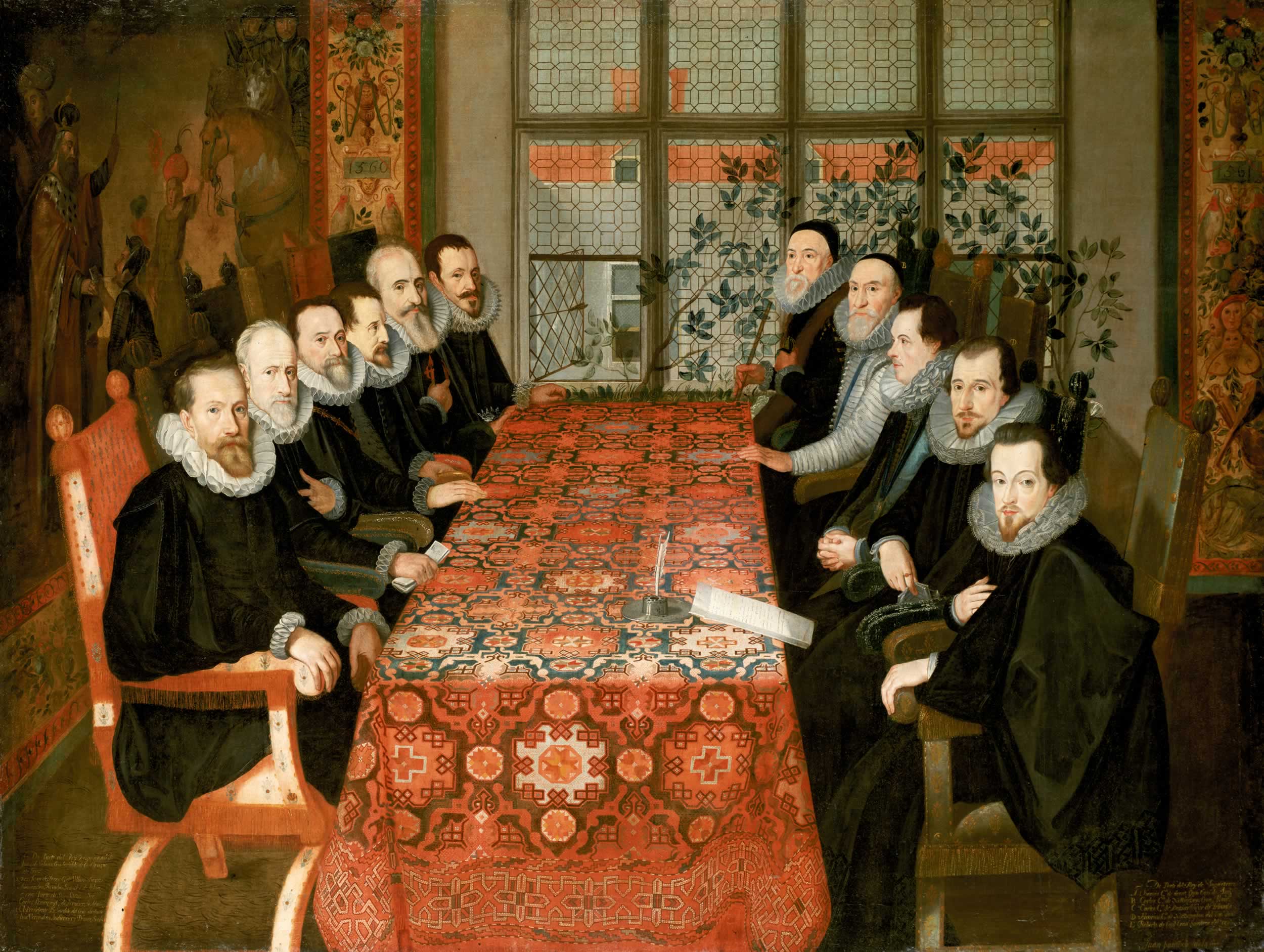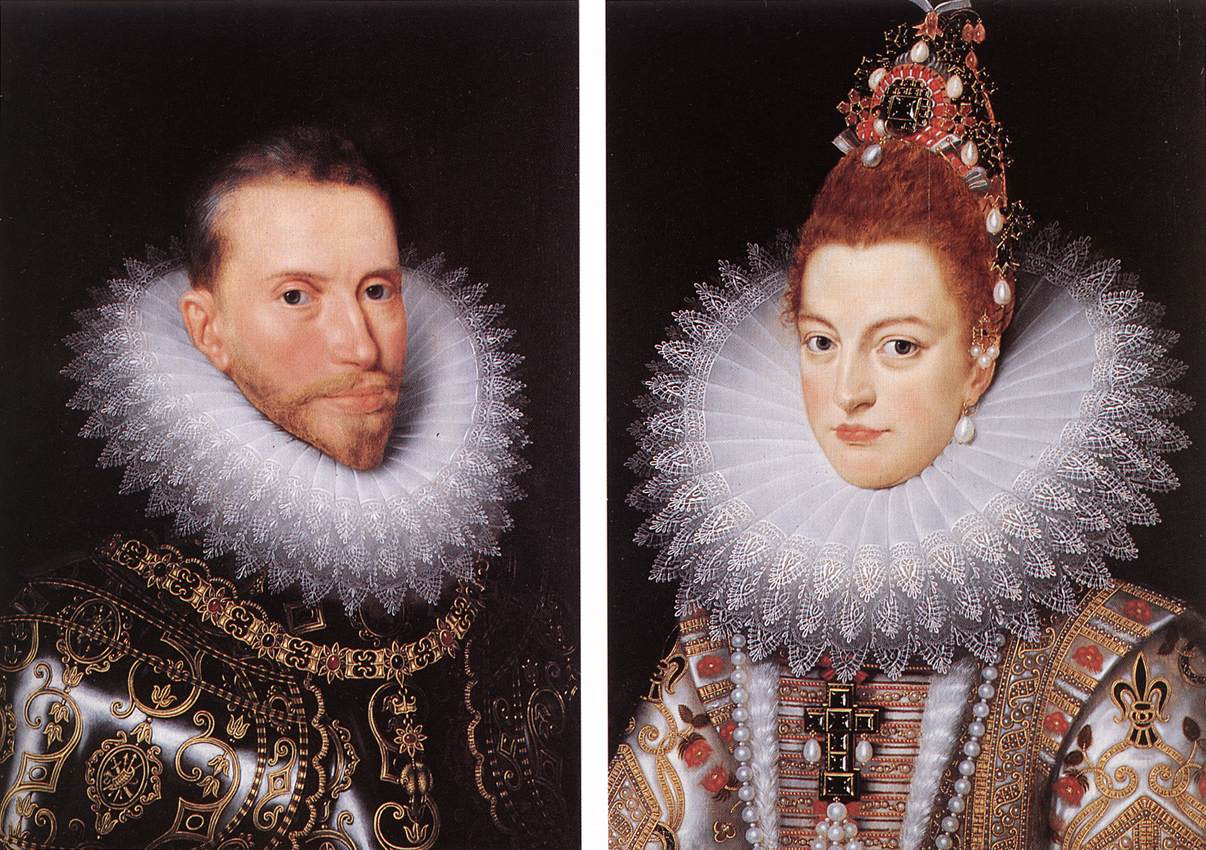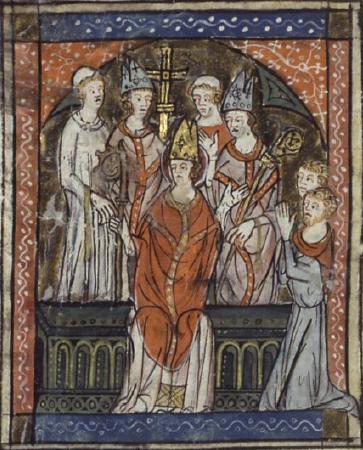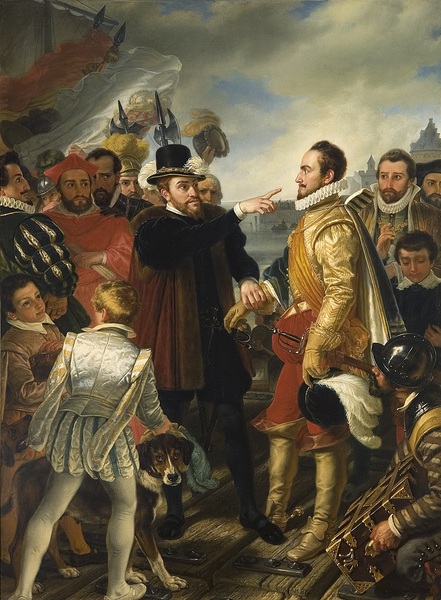|
Jean Richardot
Jean Grusset dict Richardot, knight (1540 – 3 September 1609) was a statesman and diplomat from the Franche-Comté, who held high political office during the Dutch Revolt and played an important role in restoring Habsburg rule in the Southern Netherlands. Early life and career Jean Richardot belonged to the network of families from the Franche-Comté that rose to important posts in the administration of the Habsburg Netherlands under the patronage of Antoine Perrenot de Granvelle. He was born in Champlitte in 1540 as the son of Guillaume Grusset and Marguerite Richardot. His uncle on his mother's side was François Richardot, the confessor of Margaret of Parma, a close collaborator of Granvelle and his successor as bishop of Arras. François Richardot supervised his nephew's education and furthered his first steps in the Habsburg administration. Whether out of gratitude or calculation, Jean Grusset subsequently adopted his uncle's surname. After his humanities at the Coll ... [...More Info...] [...Related Items...] OR: [Wikipedia] [Google] [Baidu] |
Albert VII, Archduke Of Austria
Albert VII (; 13 November 1559 – 13 July 1621) was the ruling Archduke of Austria for a few months in 1619 and, jointly with his wife, Isabella Clara Eugenia, sovereign of the Habsburg Netherlands between 1598 and 1621. Prior to this, he had been a Cardinal (Catholic Church), cardinal, Roman Catholic Archdiocese of Toledo, Archbishop of Toledo, List of viceroys of Portugal, viceroy of Portugal and Governors of the Habsburg Netherlands, Governor General of the Habsburg Netherlands. He succeeded his brother Matthias, Holy Roman Emperor, Matthias as reigning archduke of Archduchy of Austria, Lower and Upper Austria, but abdicated in favor of Ferdinand II, Holy Roman Emperor, Ferdinand II the same year, making it the shortest (and often ignored) reign in Austrian history. Early life Archduke Albert was the fifth son of Maximilian II, Holy Roman Emperor and Maria of Spain, daughter of Charles V, Holy Roman Emperor and Isabella of Portugal. He was sent to the Spanish Court at the a ... [...More Info...] [...Related Items...] OR: [Wikipedia] [Google] [Baidu] |
Roman Catholic Diocese Of Arras
The Diocese of Arras (–Boulogne–Saint-Omer) (Latin: ''Dioecesis Atrebatensis (–Bononiena–Audomarensis)''; French: ''Diocèse d'Arras (–Boulogne–Saint-Omer)'') is a Latin Church diocese of the Catholic Church in France. The episcopal see is the Arras Cathedral, in the city of Arras. The diocese encompasses all of the Department of Pas-de-Calais, in the Region of Hauts-de-France. The most significant jurisdictional changes all occurred during the Napoleonic wars. From 1802 to 1841, the diocese was suffragan of the Archdiocese of Paris, shifting away from the Archdiocese of Cambrai, after Napoleon dissolved the massive Archdiocese. After the defeat of Napoleon, the Napoleonic Concordat united the diocese of Arras, diocese of Saint-Omer and diocese of Boulogne together in one much larger diocese. Unlike most of the other dioceses immediately restored, it was not until 1841 that the diocese returned as a suffragan to the Archdiocese of Cambrai. History Early History ... [...More Info...] [...Related Items...] OR: [Wikipedia] [Google] [Baidu] |
Arras, France
Arras ( , ; ; historical ) is the prefecture of the Pas-de-Calais department, which forms part of the region of Hauts-de-France; before the reorganization of 2014 it was in Nord-Pas-de-Calais. The historic centre of the Artois region, with a Baroque town square, Arras is in northern France at the confluence of the rivers Scarpe and Crinchon. The Arras plain is on a large chalk plateau bordered on the north by the Marqueffles fault, on the southwest by the Artois and Ternois hills, and on the south by the slopes of Beaufort-Blavincourt. On the east it is connected to the Scarpe valley. Saint Vedast (or St. Vaast) was the first Catholic bishop in the year 499 and tried to eliminate paganism among the Franks. By 843, Arras was seat of the County of Artois which became part of the Royal domain in 1191. The first mention of the name ''Arras'' appeared in the 12th century. Some hypothesize it is a contraction of ''Atrebates'', a Belgic tribe of Gaul and Britain that used to ... [...More Info...] [...Related Items...] OR: [Wikipedia] [Google] [Baidu] |
Matthias, Holy Roman Emperor
MatthiasMátyás II of Hungary and BohemiaMatija II of Croatia (24 February 1557 – 20 March 1619) was Holy Roman Emperor from 1612 to 1619, Archduke of Austria from 1608 to 1619, King of Hungary and List of rulers of Croatia, Croatia from 1608 to 1618 and King of Bohemia from 1611 to 1617. His personal motto was ''Concordia lumine maior'' ("Unity is stronger in the light"). Matthias played a significant role in the familial opposition of the Habsburgs against his brother Emperor Rudolf II. After gaining power, he showed little political initiative of his own. The course of his politics was determined by Cardinal Melchior Klesl until his fall in 1618. As a consequence of his failed religious and administrative policies, the Bohemian Revolt, the initial theatre of the Thirty Years' War, began during the final year of Matthias' reign. Biography Early life and family Matthias was born in the Archduchy of Austria, Austrian capital of Vienna as the fourth son of Maximilian II, Holy ... [...More Info...] [...Related Items...] OR: [Wikipedia] [Google] [Baidu] |
William The Silent
William the Silent or William the Taciturn (; 24 April 153310 July 1584), more commonly known in the Netherlands as William of Orange (), was the leader of the Dutch revolt against the Spanish Habsburg Netherlands, Habsburgs that set off the Eighty Years' War (1568–1648) and resulted in the formal independence of the Dutch Republic, United Provinces in 1648. Born into the House of Nassau, he became Prince of Orange in 1544 and is thereby the founder of the House of Orange-Nassau, Orange-Nassau branch and the ancestor of the monarchy of the Netherlands. In the Netherlands, he is also known as Father of the Nation, Father of the Fatherland (; ). A wealthy nobleman, William originally served the Habsburgs as a member of the court of Margaret of Parma, governor of the Spanish Netherlands. Unhappy with the centralisation of political power away from the local estates and with the Spanish persecution of Dutch Protestants, William joined the Dutch uprising and turned against his fo ... [...More Info...] [...Related Items...] OR: [Wikipedia] [Google] [Baidu] |
Luis De Requesens Y Zúñiga
Luis de Requesens y Zúñiga (25 August 1528 – 5 March 1576) was a Spanish general, sailor, diplomat and politician. He served as governor of the Duchy of Milan (1572–1573) and as governor of the Spanish Netherlands (1573–1576). Biography Luis de Requesens y Zúñiga was born at Molins de Rei, Spanish Empire. He, and his brother Juan de Zúñiga y Requesens (Viceroy of Naples in 1579–1582), were the sons of Juan de Zúñiga, a tutor of King Philip II of Spain, Philip II, and Estefanía de Requesens. He married Gerónima Esterlich y Gralla, the daughter of Francisco Gralla, "Maestre Racional" or Finances Head Controller in Catalonia. His early career was that of a government official and diplomat. In 1563 he gained the king's confidence as his representative at Rome. In 1568 he was appointed lieutenant-general to John of Austria during the suppression of the Morisco Revolt in the Alpujarras, and he also accompanied John during the Battle of Lepanto, Lepanto campaign, his fu ... [...More Info...] [...Related Items...] OR: [Wikipedia] [Google] [Baidu] |
List Of Governors Of The Habsburg Netherlands
The governor () or governor-general () of the Habsburg Netherlands was a representative appointed by the Holy Roman emperor (1504-1556), the king of Spain (1556-1598, 1621-1706), and the archduke of Austria (1716-1794), to administer the Burgundian Netherlands, Burgundian inheritance of the House of Habsburg in the Low Countries when the monarch was absent from the territory. The role of the governors-general significantly changed over time: initially tutors and advisors of Emperor Charles V, who lived at the Palace of Coudenberg, they served as generals during the Eighty Years' War between the Kingdom of Spain and the Dutch Republic. Frequently, the governor-general was a close relative of the Austrian or Spanish monarchs, though at other times Spanish or German noblemen filled the role. The governor-general was usually based in Brussels. List of governors {, class="wikitable" style="width:80%;text-align:center" !Picture !Name !Took office !Left office !Relationship to monarch ... [...More Info...] [...Related Items...] OR: [Wikipedia] [Google] [Baidu] |
Privy Council Of The Habsburg Netherlands
The Privy Council or Secret Council (, ) was one of the three "collateral councils" (along with the Council of Finance and Council of State) that together formed the highest government institutions of the Habsburg Netherlands. Based in Brussels, it was particularly charged with legal and administrative questions. History The Council was founded on 1 October 1531 by Emperor Charles V. . Accessed 3 April 2017. He prescribed a president, eight councillors, and a secretary. |
Great Council Of Mechelen
From the 15th century onwards, the Great Council of the Netherlands at Mechelen (Dutch: ; French: ; German: ) was the highest court in the Burgundian Netherlands. It was responsible for the Dutch-, French- and German-speaking areas. In Luxembourgish the phrase "" (we'll go to Mechelen) still means playing one's last trump card. The Grote Raad first sat in the Schepenhuis in Mechelen then, from 1616, in the (old) palace of Margaretha of Austria on Keizerstraat. Origins and history The medieval rulers were assisted by advisers. Together with the ruler they formed the Council of State, also called the ''consilium'' or ''curia''. Gradually the council became more specialised, with separate financial, judicial and political council emerging. In the Burgundian Netherlands, the councils initially travelled with the Duke. In 1473 Duke Charles the Bold decided to establish the council in a specific location, in Mechelen. The council took on the name of the Parliament of Mechelen. After ... [...More Info...] [...Related Items...] OR: [Wikipedia] [Google] [Baidu] |
Philip II Of Spain
Philip II (21 May 152713 September 1598), sometimes known in Spain as Philip the Prudent (), was King of Spain from 1556, King of Portugal from 1580, and King of Naples and List of Sicilian monarchs, Sicily from 1554 until his death in 1598. He was also ''jure uxoris'' King of England and List of Irish monarchs, Ireland from Wedding of Mary I of England and Philip of Spain, his marriage to Queen Mary I in 1554 until her death in 1558. Further, he was Duke of Milan from 1540. From 1555, he was Lord of the Seventeen Provinces of the Habsburg Netherlands, Netherlands. The son of Emperor Charles V and Isabella of Portugal, Holy Roman Empress, Isabella of Portugal, Philip inherited his father's Spanish Empire in 1556, and succeeded to the Kingdom of Portugal, Portuguese throne in 1580 following a dynastic crisis. The Spanish conquests Spanish conquest of the Inca Empire, of the Inca Empire and of the Philippines, named in his honor by Ruy López de Villalobos, were completed during h ... [...More Info...] [...Related Items...] OR: [Wikipedia] [Google] [Baidu] |
University Of Bologna
The University of Bologna (, abbreviated Unibo) is a Public university, public research university in Bologna, Italy. Teaching began around 1088, with the university becoming organised as guilds of students () by the late 12th century. It is the List of oldest universities in continuous operation, oldest university in continuous operation in the world, and the first degree-awarding institution of higher learning.Hunt Janin: "The university in medieval life, 1179–1499", McFarland, 2008, , p. 55f.de Ridder-Symoens, Hilde''A History of the University in Europe: Volume 1, Universities in the Middle Ages'' Cambridge University Press, 1992, , pp. 47–55 The university's emblem carries the motto, ''Alma Mater Studiorum'' ("Nourishing mother of studies"), and the date ''A.D. 1088''. With over 90,000 students, the University of Bologna is one of the List of largest universities by enrollment, largest universities in Europe. The university saw the first woman to earn a university degree ... [...More Info...] [...Related Items...] OR: [Wikipedia] [Google] [Baidu] |
University Of Padua
The University of Padua (, UNIPD) is an Italian public research university in Padua, Italy. It was founded in 1222 by a group of students and teachers from the University of Bologna, who previously settled in Vicenza; thus, it is the second-oldest university in Italy, as well as the world's fifth-oldest surviving university. The University of Padua was one of the most prominent universities in early modern Europe, known particularly for the rigor of its Aristotelian logic and science. Together with the University of Bologna, Padua had a central role in the Italian Renaissance, housing and educating a number of Italian Renaissance mathematicians, amongst them Nicolaus Copernicus. , it is made up of 32 departments and eight schools. Padua is part a network of historical research universities known as the Coimbra Group. In 2021, the university had approximately 72,000 students including undergraduates, postgraduates, and doctoral students. History The university is conventionally s ... [...More Info...] [...Related Items...] OR: [Wikipedia] [Google] [Baidu] |







